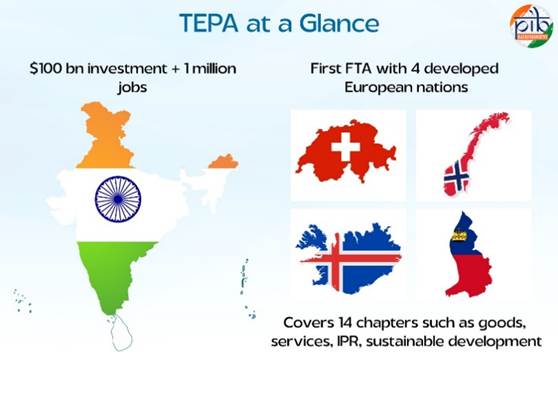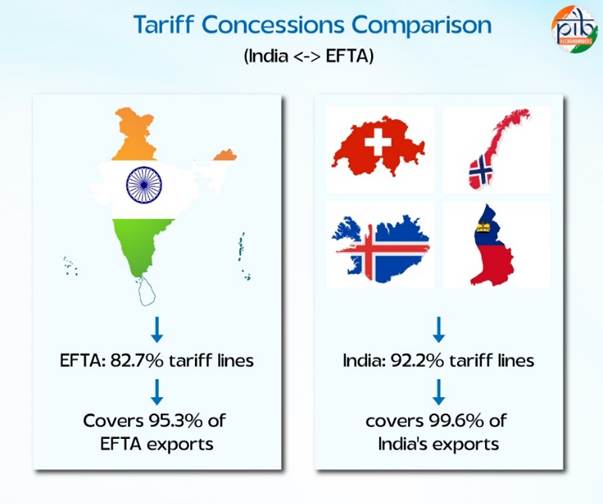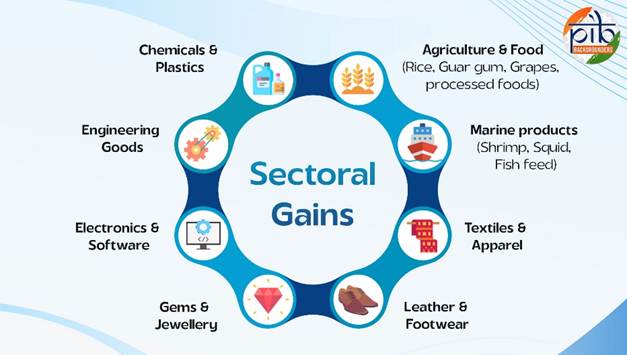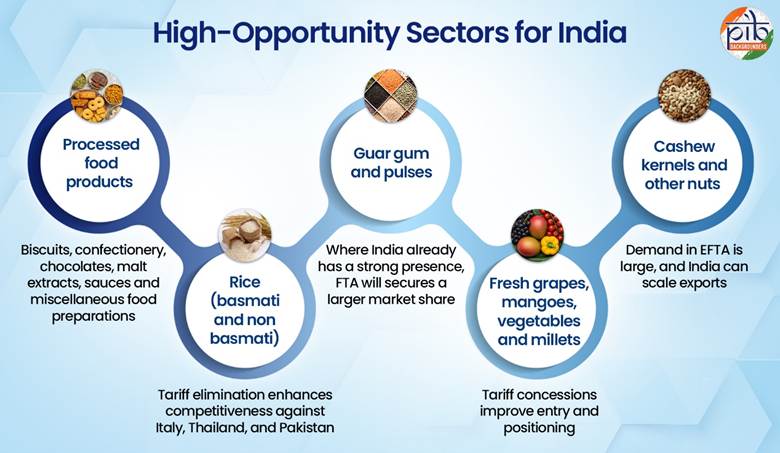PIB Headquarters
India-EFTA Trade Pact: Boosting $100 Billion Investment and 1 Million Jobs
Posted On:
11 OCT 2025 12:20PM by PIB Delhi
Key Takeaways
· India and EFTA signed the Trade and Economic Partnership Agreement (TEPA) on 10 March 2024; it took effect on 1 October 2025, marking India’s first FTA with four developed European nations.
· TEPA commits USD 100 billion in investments and 1 million direct jobs over 15 years, the first binding pledge of its kind in any Indian FTA.
· EFTA covers 92.2% of tariff lines (99.6% of India’s exports), while India covers 82.7% (95.3% of EFTA’s exports), protecting key sectors like dairy, soya, coal, and agriculture.
· The pact expands market access, drives manufacturing and innovation, and strengthens cooperation in technology and sustainability.
· Services exports gain through digital delivery, commercial presence, professional mobility, and Mutual Recognition Agreements (MRAs) in fields such as nursing, accountancy, and architecture.
|
A Defining Moment in India–Europe Economic Relations
WHAT IS EFTA?
EFTA is the intergovernmental organisation of Iceland, Liechtenstein, Norway and Switzerland. It was set up in 1960 by its then 7 Member States for promotion of free trade and economic integration between its members. EFTA is 1 important economic block out of the 3 (other 2 - EU & UK) in Europe.
|
The India–European Free Trade Association (EFTA) Trade and Economic Partnership Agreement (TEPA), signed on 10 March 2024 in New Delhi, came into force on 1 October 2025, marking a defining moment in India’s external trade policy.
This is India’s first Free Trade Agreement with four developed European nations, Switzerland, Norway, Iceland, and Liechtenstein, and one of the most ambitious in scale and intent. It represents a strategic convergence between India’s Atmanirbhar Bharat vision and EFTA’s search for resilient, diversified partnerships.
The agreement consists of 14 chapters, focusing on key areas such as market access for goods, rules of origin, trade facilitation, trade remedies, sanitary and phytosanitary measures, technical barriers to trade, investment promotion, services, intellectual property rights, trade and sustainable development, and other legal and horizontal provisions.
At its core, the agreement envisions unlocking $100 billion in investments and creating one million direct jobs in India over the next fifteen years, marking it as one of the most forward-looking trade partnerships in the country’s economic history.

WHAT IS TEPA?
TEPA (Trade and Economic Partnership Agreement) is a modern and ambitious agreement which, for the first time in any Free Trade Agreement (FTA) signed by India, includes binding commitments on investment and job creation.
|
Key Features of TEPA
Investment with Purpose
Under Article 7.1, the four EFTA states have pledged to increase foreign direct investment (FDI) in India by $50 billion within the first 10 years, followed by an additional $50 billion in the next five years.
Unlike portfolio inflows, these are long-term, capacity-building investments focused on manufacturing, innovation, and research. Over time, they are expected to generate one million direct jobs and forge deeper linkages between India’s skilled workforce and Europe’s technology ecosystems.
To streamline investment facilitation, a dedicated India–EFTA Desk, operational since February 2025, serves as a single-window platform for potential investors, focusing on renewable energy, life sciences, engineering, and digital transformation, while promoting joint ventures and SME collaborations.
Balanced Market Access
TEPA strikes a balance between ambition and prudence. EFTA has offered tariff concessions on 92.2% of tariff lines, covering 99.6% of India’s exports, including all non-agricultural goods and processed agricultural products.
India, in turn, has extended access on 82.7% of tariff lines, accounting for 95.3% of EFTA exports, but with strong safeguards. Over 80% of imports from EFTA comprise gold, where no change in effective duty has been made.
Sensitive sectors such as dairy, soya, coal, pharmaceuticals, medical devices, and select food products have been kept in the exclusion list. For products under flagship programmes like Make in India and the Production Linked Incentive (PLI) Scheme, tariff reductions are phased over 5–10 years, giving domestic industries time to strengthen before full competition opens.

A Gateway for Services and Skilled Talent
With services contributing over 55% to India’s Gross Value Added (GVA), TEPA offers a platform for next-generation trade in knowledge and digital services.
India has made commitments in 105 sub-sectors, while EFTA’s offers cover 128 from Switzerland, 114 from Norway, 110 from Iceland, and 107 from Liechtenstein. This includes key Indian strengths such as IT and business services, education, media, cultural, and professional services.
A defining element of TEPA is the inclusion of Mutual Recognition Agreements (MRAs) in professions like nursing, chartered accountancy, and architecture, a step towards smoother professional mobility.
TEPA is also expected to boost India’s services exports in core areas such as IT and business services, cultural and recreational services, education, and audio-visual services.
EFTA’s services commitments provide enhanced market access through:
Mode 1: Digital delivery of services
Mode 3: Commercial presence
Mode 4: Greater certainty for entry and temporary stay of skilled professionals
IPR, Innovation and Trust
TEPA’s Intellectual Property Rights (IPR) provisions reaffirm commitments under TRIPS, ensuring a high level of protection while preserving India’s flexibility on public health and generics.
For Switzerland, a global innovation hub, the IPR chapter reflects confidence in India’s regulatory strength, while India’s safeguards against patent evergreening protect affordable access to medicines. The balance makes TEPA a model of trust-driven cooperation between innovation and inclusion.
Sustainable and Inclusive Development
TEPA emphasizes sustainable development, inclusive growth, social progress, and environmental protection. It will foster transparency, efficiency, simplification, harmonization, and consistency in trade procedures.
Sectoral Opportunities: Where Gains Will Emerge
The India–EFTA Trade and Economic Partnership Agreement (TEPA) unlocks opportunities across a wide range of industries. With EFTA’s offer covering 92% of tariff lines, Indian exporters in sectors such as machinery, organic chemicals, textiles and processed foods will gain significantly improved access to EFTA markets. This is expected to enhance competitiveness, lower compliance costs and accelerate market entry for Indian products.

Agriculture and Allied Goods
India’s exports to EFTA, valued at $72.37 million in FY 2024–25, are dominated by guar gum, processed vegetables, basmati rice, pulses, fruits, and grapes.
TEPA reduces or eliminates tariffs across these categories, particularly in Switzerland and Norway, which together account for over 99% of India’s agri-trade with EFTA.

|
COUNTRY-SPECIFIC GAINS
|
|
EFTA Nations
|
Products / HS Codes
|
Tariff Concessions / Opportunities
|
|
Switzerland
|
Food Preparations
|
Tariffs up to 127.5 CHF/100 kg eliminated; scope for Indian exports
|
|
Confectionery, Biscuits
|
Duty cuts create opportunities in processed foods
|
|
Fresh Grapes
|
Tariffs up to 272 CHF/100 kg eliminated
|
|
Nuts & Seeds, Fresh Vegetables
|
Zero tariffs post FTA, boosting competitiveness
|
|
Norway
|
Food Preparations, Condiments
|
Duty-free access on several tariff lines
|
|
Rice
|
Tariff reductions (non-feed purposes) open new markets
|
|
Processed Vegetables & Fruits
|
Duty-free access on selected lines
|
|
Biscuits, Malt Extracts, Beverages
|
Tariff relief improves access for Indian brands
|
|
Iceland
|
Processed Foods
|
High MFN tariffs (up to 97 ISK/kg) cut to zero
|
|
Chocolate & Confectionery
|
Duties eliminated; strong potential for processed food exports
|
|
Fresh/Chilled Vegetables
|
Tariff elimination
|
Coffee and Tea
EFTA countries together import $175 million worth of coffee, nearly 3% of global trade.
With zero duty on all coffee lines, TEPA enables Indian producers to access premium markets in Switzerland and Norway, ideal destinations for shade-grown and handpicked Indian coffee.
For tea, EFTA’s small but high-value market (~3 million kg annually) has already reflected benefits, India’s average export realisation rose to $6.77/kg in 2024–25, up from $5.93/kg the previous year.
Marine Products
Under TEPA, Indian marine products will benefit from significant tariff concessions across EFTA countries:
|
COUNTRY-WISE MARKET BENEFITS
|
|
Norway
|
Exemption of duty of up to 13.16% on fish and shrimp feed, making Indian products more competitive and enhancing exports of feed and raw materials.
|
|
Iceland
|
Tariff elimination of up to 10% on frozen, prepared and preserved shrimps, prawns, squid and cuttlefish, along with reductions of up to 55% on fish feed.
|
|
Switzerland
|
Zero duty on fats and oils of fish (excluding liver oil).
|
Industrial and Manufacturing Gains
Engineering goods exports to EFTA stood at $315 million in FY 2024–25, up 18% year-on-year. The agreement expands market access for electric machinery, copper products, energy-efficient systems, and precision engineering.
Textiles and apparel, valued at $0.13 billion, and leather and footwear will benefit from duty stability and simplification of standards, while sports goods and toys gain from zero-duty access and mutual recognition of conformity standards.
For gems and jewellery, TEPA consolidates duty-free access across EFTA, ensuring long-term predictability for exporters in diamonds, gold, and coloured gemstones.
Electronics and Software
With a USD 100 billion investment commitment and preferential access to high-income European markets, TEPA provides a strategic springboard for India’s electronics sector — particularly for MSMEs and OEMs looking to scale globally.
|
COUNTRY-WISE MARKET POTENTIAL
|
|
Switzerland
|
Medical electronics (diagnostic devices, wearables), smart sensors and embedded systems, secure communication modules (for fintech and banking).
Strategic edge: Leverage TEPA’s IPR chapter to protect proprietary technology.
|
|
Norway
|
EV components and battery management systems, marine electronics (navigation, sonar, IoT buoys), smart grid and energy monitoring devices.
Strategic edge: Align with Norway’s climate-tech goals and public procurement channels.
|
|
Iceland
|
Compact medical devices and diagnostics, smart home and energy-efficient electronics, educational tech hardware (tablets, sensors).
Strategic edge: Target niche distributors and public health initiatives
|
|
Liechtenstein
|
Industrial control systems, secure embedded electronics for banking, high-precision components for OEMs.
Strategic edge: Position India as a reliable EMS partner for European OEMs.
|
Chemicals, Plastics and Allied Products
EFTA has granted zero or reduced tariffs on 95% of India’s chemical exports, cutting pre-FTA duties of up to 54%.
Exports are projected to grow from $49 million to $65–70 million, particularly in pet food, rubber, ceramics, and glassware.
For plastics and shellac-based products, TEPA enables diversification into high-value European markets, reducing reliance on tariff-heavy destinations like the U.S.
A Partnership Rooted in Mutual Confidence
For India, TEPA is more than a trade pact, it is an instrument of strategic trust with like-minded economies that value transparency, rule-based trade, and innovation.
It also demonstrates a mature approach to trade liberalisation, one that protects domestic interests while projecting India as a reliable partner in global supply chains.
By opening doors to investment, employment, technology and sustainability, TEPA captures the essence of a modern economic partnership, ambitious, balanced, and forward-looking.
Conclusion
The India–EFTA Trade and Economic Partnership Agreement (TEPA) represents a historic milestone, establishing India’s first FTA with four developed European nations. It brings with it commitments of USD 100 billion in investments and the creation of 1 million direct jobs over the next 15 years. The agreement enhances market access for goods and services, strengthens intellectual property rights, and promotes sustainable and inclusive development, while advancing the objectives of Make in India and Atmanirbhar Bharat.
References
Ministry of Commerce and Industry
https://www.commerce.gov.in/international-trade/trade-agreements/india-efta-tepa/
https://www.pib.gov.in/PressReleaseIframePage.aspx?PRID=2013169
PIB
https://www.pib.gov.in/PressNoteDetails.aspx?NoteId=154945&ModuleId=3
https://www.pib.gov.in/PressReleasePage.aspx?PRID=2173138
Click here to see pdf
***
VV/M
(Release ID: 2177724)
Visitor Counter : 3910